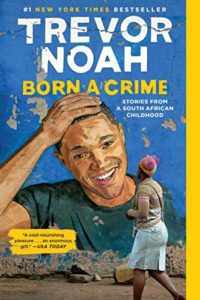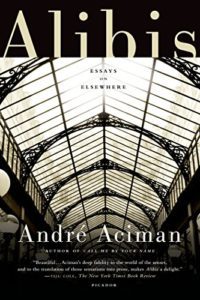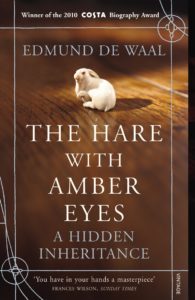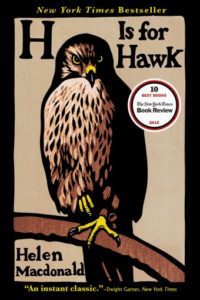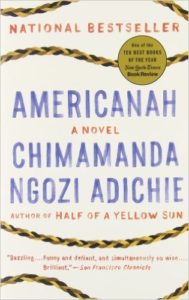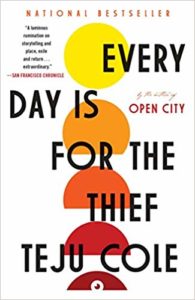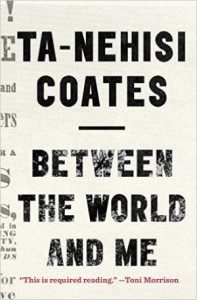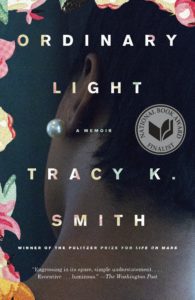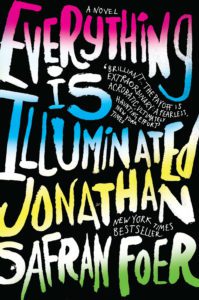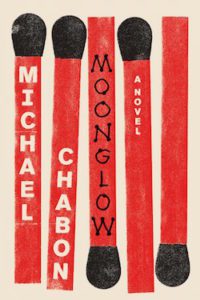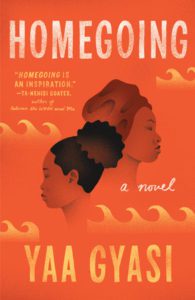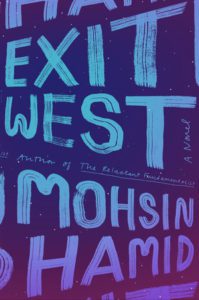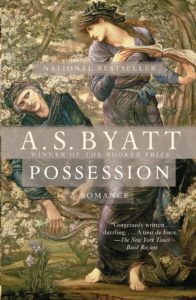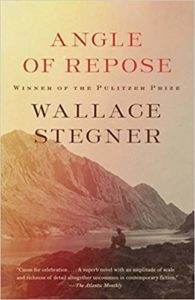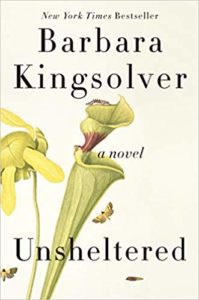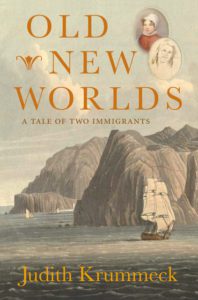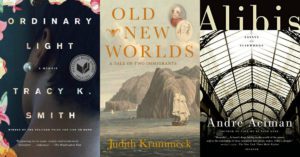
Bifurcated—from the Medieval Latin word for two-pronged—encapsulates for me the experience of being an immigrant; I tend to feel as if I have two countries, but no home. Although I prefer to think of this as being spoiled for choice with more than one country to choose from, there’s no doubt that my heart is in Africa, while my head is in America—and sometimes vice versa.
To add to the dichotomy, I’ve been spanning two centuries lately, as I’ve searched for the story of my English great-great grandmother, who planted our family in South Africa in the early 1800s. To borrow from Joan Didion’s phrase, I tend to read, “to find out what I’m thinking, what I’m looking at, what I see and what it means.” So over the past few years, as I’ve been writing about my divided life, I’ve found myself drawn to books that explore a duality of place or time, and sometimes both.
***
Born a Crime: Stories from a South African Childhood by Trevor Noah
Trevor Noah’s life is the epitome of bifurcation—born to Xhosa and Swiss parents, and growing up in South Africa before making a tremendously successful career in America. He seems to welcome it. Perhaps, in his quiet and solitary moments, he ponders about his duality but—both on The Daily Show and in his autobiography—I feel that he embraces it. He is an uncanny mimic, he is a polyglot, he uses his South African background to make sense of America, and the other way around. It’s enviable—and highly entertaining.
Alibis: Essays on Elsewhere by André Aciman
While each of these linked essays—about time, place, and identity—by the Egyptian-born writer, André Aciman, touched a chord, it was the sixth one, “A Literary Pilgrim Progresses to the Past,” that most made me feel a click of recognition. It contains Aciman’s now well-known quote, “A hidden nerve is what every writer is ultimately about.” His hidden nerve is place, and mine is too, so this was where my literary journey began.
The Hare with Amber Eyes: A Hidden Inheritance by Edmund de Waal
There is so much to love about this family memoir: having de Waal as a personal guide through Odessa, Vienna, and Paris; learning about the Japanese netsuke miniature sculptures in the process of his search across time and place for their history in his family; and most of all the slowly unfolding story of his once-wealthy European Jewish family from 1871 to 2009. The idea of a family memoir intrigued me, and informed my earliest thoughts about how I might begin to search for, and write about, my own familial history across time and place.
H Is for Hawk by Helen Macdonald
In one sense, Helen Macdonald’s memoir, about coming to terms with grief after her father’s death, is fairly familiar territory. What makes it distinct is the manner of her healing, as she set about training a goshawk named Mabel. I loved her personal story, and was also intrigued by the “shadow biography” of the writer T. H. White, famous for his series of Arthurian novels, who had attempted to train a hawk, as he recounted in his book, The Goshawk. Macdonald’s interweaving of these dual narratives is intriguing, and it helped me to see a way to crafting a biographical memoir of my own.
Americanah by Chimamanda Ngozi Adichie
What struck me most about Chimamanda Ngozi Adichie’s novel is how universal the immigrant experience is, even as each is unique. I could empathize with the outsider strangeness, the sense of being always other. For Adichie’s character, Ifemelu, there was the added dimension of a Nigerian woman having to confront, for the first time, what it meant to be a black person, within the context of a racist society. Conversely, but also disconcertingly, I had experienced the guilt of being part of a white minority in apartheid South Africa. There’s also the undercurrent that Adichie explores in her novel of whether or not we, as immigrants, would go back to live in our home country.
Every Day Is for the Thief by Teju Cole
And then there is Teju Cole’s novel—although I can’t help feeling that it has memoirist elements to it—of an unnamed protagonist who does, in fact, go back to his native country of Nigeria after fifteen years away, only to find that he no longer feels as at home there as he does in New York City. This is exactly the dilemma of so many immigrants: that we don’t fully belong in either our native or our adoptive countries. For years, I felt this as a lack. But, when I went back to Africa to research my great-great grandmother’s story, I found serendipitous connections there that I could only have come across because of my being grounded in, and native to, Africa. My life is now in America, but my roots are unquestionably in Africa. Cole’s book helped me to start to think about how we might not have to choose, but could embrace both.
Between the World and Me by Ta-Nehisi Coates and Ordinary Light by Tracy K. Smith
I read these two books in quick succession after the Freddie Gray riots in my adopted city of Baltimore. These were the city’s worst race riots in a generation, and the unrest was hauntingly reminiscent of the race riots that I had lived through, but not been directly affected by, in apartheid South Africa. It was hard for me to believe that, all these decades after America’s civil rights movement, there could still be such a division of “them and us.” In his book, Ta-Nehisi Coates gave me the clearest sense yet of what it must be like to inhabit a black person’s body in America, but I was dismayed by his pessimism about racial divisions ever being healed. I needed another opinion.
In Tracy K. Smith’s memoir I could sense the universal kinship of any young person coming of age in any country. Her father, for instance, was stationed for a time at Travis Air Force base in California, and so was my husband’s father. Even given their difference in age, race, and gender, was their experience so very disparate, I wondered, and I want to hope not. As much as Smith was sharing her experience of coming to identify herself as a black woman in America, I could relate to any individual’s road to self-discovery, not necessarily based on ethnicity, gender, or country of origin.
Everything Is Illuminated by Jonathan Safran Foer and Moonglow by Michael Chabon
Again, I’m going to pair two books, not because their authors’ writing styles are anything alike, but because they are both Jewish men writing about tracing their heritage. Both books deal with narrators in search of their histories, which are bound up, in one way or another, with the Holocaust. Are these author/narrators Jewish first and foremost, or American? What is it in their past histories that resonates in the present lives of the authors? Are these questions about duality even answerable? My takeaway from reading both these books was that digging back into the past, and writing it down, begins the dialogue that can help to unravel the answers.
Homegoing by Yaa Gyasi
When a poet friend learned that I was writing about my British ancestors going to Africa to minister to the indigenous people there, with all the conflict about colonialism that this brought to the surface, she suggested Yaa Gyasi’s book to me. Gyasi was born in Ghana, which played a role in slavery during colonialism, and was brought up in Alabama, which has such an abysmal slave history of its own, and she unpacks the implications of colonialism and slavery across centuries, generations, and two countries. My poet friend was right: Gyasi’s sprawling multi-generational family saga, tracing two distinct lines from the same family tree, made a deep impact.
Exit West by Mohsin Hamid
Throw a little dash of magical realism into the mix of immigrants and where they belong, and you have the ingredients for this novel by the Pakistani writer, Mohsin Hamid. The divided lives of immigrants and refugees are plain to see, but what makes the book particularly alluring is the way Hamid breaks down that barrier of “other.” The young couple, Saeed and Nadia, could be any lovers anywhere in the world, and it is their very ordinariness—their cell phones, their banter—that makes one look at their crisis of statelessness with a new empathy, and also with hope.
Possession by A. S. Byatt
When I felt as if I was living in two centuries during the search for my great-great grandmother’s story, I decided to re-read A.S. Byatt’s 1990 novel. In doing so, I realized how deeply the book had lodged in my subconscious after I’d first read it. I was thrilled all over again by the dual narrative of two twentieth-century academics reaching back through research and letters to excavate the lives of two Victorian poets. Although Byatt’s story was pure, ingenious fiction, and mine was based in fact, I could see how her treatment had formed the template for writing about my search into my ancestral past.
Angle of Repose by Wallace Stegner
The last two novels on my list are also dual narratives. My publisher at Green Writers Press recommended Wallace Stegner’s Pulitzer Prize winner based on the fact that Stegner’s protagonist, who is dealing with life issues of his own, is researching and writing about a pioneering female ancestor. In Angle of Repose, the character of the protagonist’s grandmother was based on the real life story and materials of the American writer and illustrator, Mary Hallock Foote. Although Stegner openly acknowledged this, and used the material with the family’s permission, it generated a fair amount of controversy. It didn’t bother me at all—perhaps because I had also “bent” the rules in having to rely on some fairly liberal imaginings to flesh out my great-great grandmother’s story, a fact which I acknowledge in the book.
Unsheltered by Barbara Kingsolver
More recently, there is Barbara Kingsolver’s latest novel, which intertwines the stories of a twenty-first century writer who is trying to keep her ramshackle house from falling down in Vineland, New Jersey, and a nineteenth-century male scientist who had similar concerns about the same house half a century earlier. Again, one of the characters comes from real life—the naturalist, Mary Treat, who corresponded with Charles Darwin and made contributions to zoology and botany—as the twenty-first century writer researches her story and the nineteenth-century scientist befriends her. I loved the blending of fact and fiction, of different time spans, of seemingly divided lives—and the way that Kingsolver finds a commonality for all the disparate elements to cohere.
And to close out this wonderful list, we just had to include Judith’s new book, Old New Worlds: A Tale of Two Immigrants, out now from Green Place Books! – Ed.
Old New Worlds: A Tale of Two Immigrants by Judith Krummeck
Old New Worlds intertwines the immigrant stories of the author and her great-great grandmother. Sarah Barker and her new husband sail from England in 1815 to minister to the indigenous Khoihoi in South Africa’s Eastern Cape. In the midst of conflict, illness, and natural disasters, Sarah bears sixteen children. Two hundred years later, Judith leaves post-apartheid South Africa with her new American husband to immigrate to the United States. She is drawn to Sarah’s immigrant story in the context of her own experience, and she sets out to try and trace her. In the process, she finds a soul mate.

